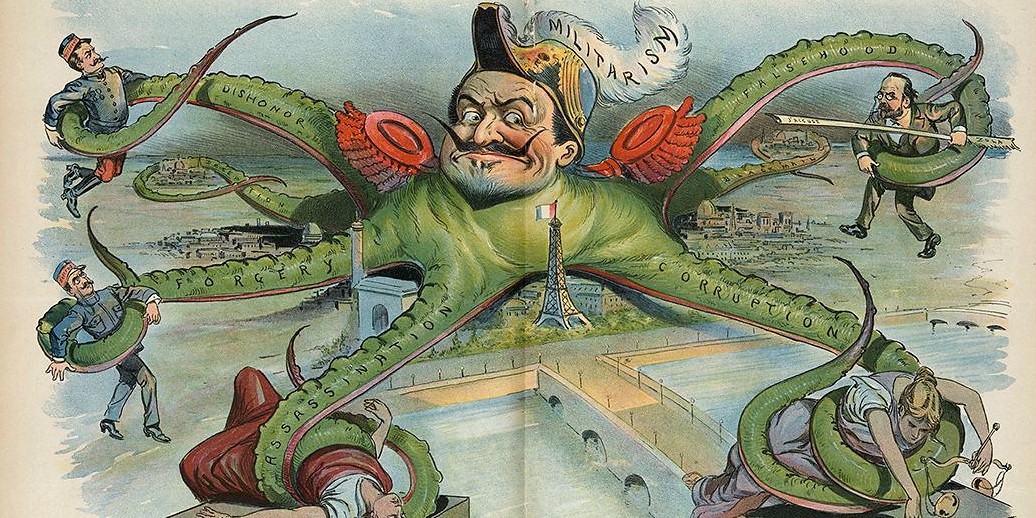The Alfred Dreyfus Affair: A Chronology

October 9, 1859
Alfred Dreyfus is born in Mulhouse, a town in Alsace, near the German and Swiss borders.
1876–1877
In Paris, Dreyfys attends the Collège Sainte-Barbe, Dreyfus prepares for the entrance examination for the Ecole Polytechnique.
April 21, 1890
Dreyfus marries Lucie Hadamard, age 20.
1890–1892
Dreyfus attends the Ecole de Guerre in Paris, and graduates 9th in his class.
November 19, 1892
Dreyfus begins an internship at the Army General Staff Office.
July 24, 1894
Major Esterhazy offers to sell French military secrets to the German foreign officer Schwartzkoppen.
September 26, 1894
A document providing secret military information to Schwartzkoppen is recovered from a wastebasket at the German Embassy in Paris and turned over to the French Ministry of War.
October 6, 1894
Officials in the War Ministry focus on Alfred Dreyfus as the likely author of the letter to Schwartzkoppen (called the bordereau). Anti-Semitism has a lot to do with it.
October 15, 1894
Dreyfus is arrested and jailed on charges of high treason. For the next couple of weeks, he is questioned frequently.
June 27, 1894
Jean Casimir-Périer is elected President of the Republic of France.
December 19, 1894
Dreyfus’s court-martial begins in Paris.
December 22, 1894
Dreyfus is convicted of high treason, sentenced to permanent deportation in a fortified enclosure and stripped of his rank
January 5, 1895
In a degradation ceremony at Ecole Militair in Paris, Dreyfus is stripped of his rank in the main courtyard.
April 1895
Dreyfus arrives in Devil's Island and is lodged in solitary confinement in a stone hut.
January 17, 1895
Félix Faure is elected President of the Republic of France.
August 30 or 31, 1896
Georges Picquart, the new Director of the Statistics Section at the Ministry of War, examines handwriting and the secret dossier used to convict Dreyfus. He becomes convinced that Dreyfus was not the real spy, rather Esterhazy was. Over the next few years, Picquart becomes Dreyfus’s most important defender. But most high officials in the army dig in and resist requests to reopen the case.
October 1895–December 1897
The Dreyfus family's petitions and appeals to the authorities remain fruitless. On November 15, Dreyfus’s brother, Mathieu, writes to General Billot accusing Esterhazy of being the real traitor and demanding Alfred be freed.
January 13, 1898
Novelist Emile Zola publishes his defense of Dreyfus (and attack on the military leaders behind his prosecution) in an open letter to the president of France called “I Accuse!”
July 5, 1898
Lucie Dreyfus asks the Minister of Justice to overturn the 1894 judgment against her husband.
August 1898
The forgeries of Captain Henry that helped convict Dreyfus are publicly exposed.
June 3, 1899
The Court of Cassation overturns the 1894 court-martial verdict against Dreyfus and orders a new court martial in Rennes.
February 18, 1899
Émile Loubet is elected President of the Republic
June 9 – July 1, 1899
Captain Dreyfus is shipped back to France from Devil's Island and transferred to the military prison in Rennes.
August 7 –September 9, 1899
A second court-martial takes place in Rennes. By a vote of 5 to 2, Dreyfus is found guilty with extenuating circumstances. He is sentenced to ten years in prison.
September 12, 1899
Dreyfus withdraws his request for appeal to facilitate a prompt decision by the president on a request for a presidential pardon.
September 19, 1899
President Loubet pardons Alfred Dreyfus, claiming he is doing so because of Dreyfus’s poor health.
September 21, 1899
Alfred Dreyfus rejoins his family in Carpentras
8 March 1900
Alfred Dreyfus protests the amnesty law adopted by the Senate on 2 June
October 5, 1902
Dreyfus attends Emile Zola's funeral ceremony.
April 7, 1903
The French government opens an administrative enquiry into the process that led to Dreyfus’s convictions.
February 1, 1904
Alfred Dreyfus files a report on the Affair.
July 12, 1906
The Court of Cassation declares Dreyfus innocent, overturning his earlier conviction.
13 July 1906
The Chamber of Deputies confers the rank of squadron leader on Captain Dreyfus and awards him a Knight's Cross in the Legion of Honor
October 5, 1906
Alfred Dreyfus is made artillery commander.
June 26, 1907
Having lost any hope of attaining the rank of general because of his years spent in prison, Dreyfus requests retirement from the army.
June 4, 1908
Dreyfus is shot and wounded during the transfer of Zola to the Pantheon. His would-be assassin is later acquitted.
1914–1918
Dreyfus serves in World War I, first being assigned to the general staff of the artillery section of the retrenched Paris camp, and then to the artillery depot of the 168th division.
July 12, 1935
Alfred Dreyfus dies in Paris. Two days later, he is buried in the Montparnasse cemetery.
